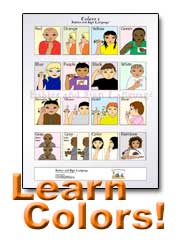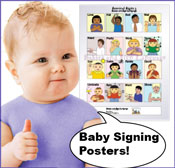Babies and Sign Language Com - Site Bio
Hello!
Thank you very much for visiting our site! My name is MJ and the topic of babies using sign language fascinates me completely.
Here’s how my interest began…
While I studied for my Master's in Linguistics of American Sign Language at Gallaudet University, I learned that hearing babies of Deaf parents could sign before hearing babies of Hearing parents could speak.
I also learned through classes and research that babies gesture naturally in attempts to communicate and tend to grasp gestures earlier than acquiring vocalization skills. Babies are aware of communication by an early age; at 2 months of age, an infant is already able to copy your facial expressions!
As I delved further into research, I came upon two great pioneers of this same research - Joseph Garcia and Linda Acredolo (with Susan Goodwyn et al). These two people furthered my zeal to learn and know all I could about infants learning sign language.
When our son was 16 months old - he had an ASL sign vocabulary of about 45 - 55 words, and a spoken vocabulary of about 20 words. We feel that he can vocalize so many spoken words consistently due to his early understanding of the benefits of communicating his own specific thoughts.
We also feel that learning baby signs, our son had less frustrations and tantrums, because of the ability to express himself this much sooner/earlier – so that his needs are/were met immediately.
Allow me to tell you a brief story. One time, my son and I were at a restaurant. In the next booth was an 18 month old, who kept frustratingly pointing and vocalizing the 'unh, unh'. Her mother, desperate to figure out her daughter's needs, picked up object after object saying 'this? This? Is this what you want?' Seconds later, our son looked at me and used the ASL sign for 'drink'.
Delighted, I asked him 'what would you like to drink?' and he signed 'milk'. Not only did we know our son was thirsty, but we knew exactly what he wanted to drink!
Not only can you know your child's wants and needs, but you can also know what she or he is thinking.
Another morning, after my sister left from her visit, our 16 month-old picked up my sister's key-chain and signed 'Auntie's keys'! (She had forgotten them on the way out!)
Signing will allow your baby to initiate conversations. It
will delightfully amaze you! Infants are currently lacking in the fine
motor skills necessary to produce spoken language but this does not mean that they lack the conceptual ability to understand and use language.
So imagine how frustrating to a baby or toddler who wants to share and talk about everything that is new to her/him. Keep in mind -- this infant already has the mental capabilities, but simply (and quite normally) lacks the specific physical capabilities needed in order to speak.
It’s no wonder why there are so many tantrums and outbursts at this age.
That’s why I’m happy to share with and tell you a little about the amazing benefits of working with babies to communicate manually, just until they are able to master their own vocal chords.
Using signs, your 9 month old can tell you if she wants JUICE and not MILK, or where she HURTS.
An excited 12 month old at the zoo would of course have
trouble pronouncing the words ‘elephant’ or ‘kangaroo’, but could
easily produce the signs ELEPHANT and KANGAROO!
I have currently developed a small signing glossary that will provide you with the first 20 commonly used “survival” signs, as to facilitate your search.
Please try not to feel frustrated if it seems like your baby isn’t ‘getting it’. S/he is. Just as some babies have individual time spans for sitting up, rolling onto back/belly, crawling, walking, etc. – The same applies to your baby acquiring signs.
Remember, American Sign Language is the 3rd most common used language in the US, so you will be providing your baby with a second language, should you continue to teach your baby sign language after 36 months of age.
Now that you are armed with all the basic information that you and your infant or toddler will need to learn signs, please do not wait any longer! Your baby will amaze you! For your first three signs, expect anywhere from 2 weeks to 2 months for your baby to sign back to you. After that, Baby picks up more quickly.
Most parents begin with the sign “more”, “milk”, and “finished”. I would like to suggest that you add a ‘motivational’ sign or two (such as ‘dog’ or something your baby shows delight in seeing).
Good luck, Be patient, and have fun!
And again, thank you for visiting our site!
Sincerely,
MJ and JohnFun activities you can share with your baby in sign










